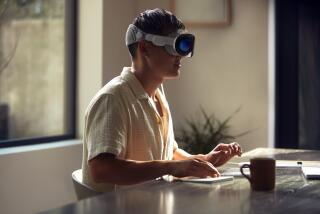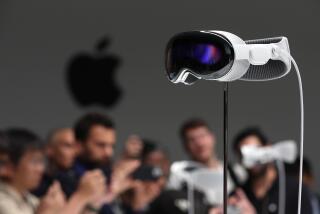Google Glass sees all and that’s a worry
SAN FRANCISCO — On a recent afternoon, Homer Gaines hiked with girlfriend Tami Stillwell to the gusty peak of Angel Island in the San Francisco Bay, bent down on one knee and slipped a topaz and white-sapphire ring on her finger, capturing the entire marriage proposal on a computerized device that he was wearing like a pair of glasses.
Gaines, a 41-year-old Web developer from Fort Myers, Fla., is one of 10,000 “explorers” testing Glass, the much talked about hands-free wearable computing device from Google that lets users take photos and videos, make phone calls, send and receive text messages, search the Internet and get turn-by-turn directions.
“I would not have been able to pull off that level of spontaneity with any other device and instantly share it with the world,” Gaines said. “Glass gave me the ability to share with everyone that special moment from my point of view -- the surprise on her face, the way she jumped around, the ring on her finger and the tears of joy in her eyes.”
Glass won’t be widely available for purchase until early next year, but it’s one of the most anticipated new technologies in years. The question many are asking: Can Google make digital goggles the world’s next must-have gadget?
As Google sees it, Glass is a revolutionary new way to quickly and effortlessly connect people with information.
Critics view Glass as an invasive new technology that -- if it takes off -- could rob people of what few shreds of privacy they have left.
Lawmakers are alarmed by the privacy implications and have begun asking pointed questions of Google. And some commercial establishments -- most notably casinos and bars -- have already banned Glass.
Google is downplaying the privacy and security risks, assuring the public that it will not permit facial recognition apps (or porn apps, for that matter). Google says it’s obvious when someone is taking pictures or recording a video on Glass.
But some developers have already built a way to get around Google: an alternative operating system that runs on Glass but is not controlled by Google. One developer is making a facial recognition app that will help users remember the hundreds of people they have met and should recognize but don’t.
That in-your-face quality of Glass could wake up more people to their ever shrinking privacy in the rapidly advancing digital age, University of Washington law professor Ryan Calo said.
Not only will people be more keenly aware that they have no reasonable expectation of privacy in public, Glass and devices like it could make it easier for government authorities to gain access to everything they see and record without a warrant, he said.
And, with a warrant, the government might even be able to remotely turn on Glass’ video recording capability without the user’s knowledge, the way it has done with OnStar systems in cars, Calo said.
To counter that kind of growing apprehension, Google is trying to make the new technology seem as normal as possible.
Google co-founder Sergey Brin constantly has a pair perched on his nose. He has worn Glass to the Oscars, to the TED conference, and in the Hollywood film “The Internship,” and last year he stole the show at Google’s annual developers conference by sky-diving onto the roof wearing Glass.
His cohort, Google Chief Executive and co-founder Larry Page, recently sported a pair as a groomsman in a wedding ceremony in Croatia. And he talked up Glass as the future of technology during Google’s second-quarter earnings conference call with analysts.
Still, even inside the high-tech industry, some aren’t too keen on Glass. Los Angeles technology entrepreneur and investor Jason Calacanis has asked friends to remove Glass in his presence, banned Glass from poker games and coined a new term to describe what he feels like doing when he spots Glass wearers: “Glass-kicking.”
And Glass hasn’t been able to ditch what could be its true Achilles’ heel: its dorky image. Labeled “Segway for your face,” it has become the butt of jokes on late-night television and on the Internet. Not only have Glass wearers been subjected to public ridicule for looking “glassed out,” they are referred to as a cross between Glass and a curse word.
Google is the first to admit that Glass is not quite ready for prime time, with widely reported glitches. The battery drains quickly (but also charges quickly). The capabilities are still very limited, with only a smattering of apps such as Twitter, Facebook and Tumblr. And some complain that it’s not easy to hear notifications or phone calls with the bone conduction speaker.
Perhaps the most glaring omission: A way for the 64% of the U.S. population who wears glasses to use Glass. Google has made a prototype of prescription frames designed to be compatible with Glass and said the company will release specifications for frames manufacturers.
“We still have bumps in the road and obstacles,” Glass product director Steve Lee said. “Right now, you need to be an early adopter who is excited about the technology.”
Glass is the first major product from Google X, the company’s super-secretive research laboratory for “moonshots,” big scientific bets such as self-driving cars. The lab is located in two nondescript brick buildings about half a mile from Google’s Mountain View, Calif., campus. A row of electric cars -- including Teslas -- is parked and charged out front.
In a conference room inside Google X, Lee showed off an early prototype of Glass: safety glasses with a Nexus One smartphone attached to the right temple and the phone’s battery attached to the left. The device clearly didn’t win any style points and was not terribly comfortable (“guaranteed to give you a headache in 10 minutes,” Lee said).
Over the last three years, Google has dramatically refined Glass. The latest incarnation weighs about the same as a pair of normal glasses and is more attractive and less obtrusive. To keep careful watch over every detail, Google turned to Foxconn to manufacture Glass near its campus but won’t disclose the exact location.
And Google chose a marketing strategy as novel as Glass. This summer, it opened three upscale pop-up stores that it calls “basecamps” -- in a San Francisco office tower on the waterfront, in a penthouse in the Chelsea neighborhood of New York and in Google’s Venice Beach offices -- to give thousands the white-glove treatment as they are outfitted with Glass.
This shopping experience is even more exclusive than most.
Explorers not only stretched their pocketbooks to be the first to test Google’s $1,500 device, they competed in an online contest for the privilege.
“This is a big, new leap in tech, and I think it’s really important to get feedback on product and how people use it. Why would you do that in a vacuum, when you can do it with people across the United States?” said Ed Sanders, Google’s head of marketing for Glass.
“When you are inventing something new and something that by its very nature is very intimate and personal, a device that someone wears on his or her face, then you have to listen to people,” Sanders said.
In the San Francisco basecamp, an airy room with exposed ductwork, concrete floors and sweeping views of the bay, explorers first pick from five colors -- demure hues of white, gray and black or bright pops of orange and blue -- and then take a seat at wood tables. On each table sits a black shopping bag, a Chromebook Pixel laptop and a mirror.
One by one, guides deliver white boxes with the silver Glass logo. Inside the box under a single sheet of white filmy paper is Glass. The guides custom fit the lens-less glasses, bending the titanium and adjusting the nose guards.
The explorers drink chilled champagne and craft beer as they slide their fingers back and forth along the right side of the device and stare into a screen the size of a postage stamp above their right eye.
Soon they are ordering Glass around with ease, dictating messages to family and friends and making plans to take Glass sightseeing, even hang-gliding.
Erica Pang, 24, who works for a Palo Alto start-up, and her brother Aaron Pang, 20, a junior at Washington University recovering from spinal lymphoma, entered the #ifihadglass contest. She was picked. Their idea: to broadcast live virtual field trips to museums and zoos for children who are immobilized by illness or stuck in hospital beds.
They got the idea when Aaron spent three months in the hospital.
“We want to let kids see the world without any of their limitations getting in the way,” Erica Pang said.
Michael Kendle, an app developer from Springfield, Miss., in flip-flops and jeans and lounging on a gray couch at the Google basecamp, is a self-professed gadget junkie and says he always has to be the first to get the new, new thing. Now he has Glass, and he says he plans never to take it off except to shower and sleep.
“I love being connected to everything, to have all this information at my fingertips,” Kendle said.
--
Times staff writer Dawn C. Chmielewski contributed to this report.






